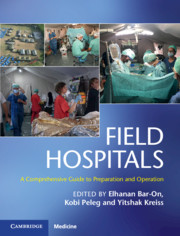Book contents
- Field Hospitals
- Field Hospitals
- Copyright page
- Contents
- Contributors
- Preface
- Section 1 History
- Section 2 Scenarios
- Chapter 3 Definitions, Needs, Scenarios, Functional Concept, and Modes of Deployment
- Chapter 4 Needs Assessment
- Chapter 5 Predeployment Operational Planning and Preparations
- Section 3 Operational Considerations
- Section 4 Clinical Considerations
- Section 5 Additional Contextual Considerations
- Index
- Plate Section (PDF Only)
- References
Chapter 4 - Needs Assessment
Forecasting the Needs and Improving the Immediate Medical Response in Complex Emergencies
from Section 2 - Scenarios
Published online by Cambridge University Press: 09 January 2020
- Field Hospitals
- Field Hospitals
- Copyright page
- Contents
- Contributors
- Preface
- Section 1 History
- Section 2 Scenarios
- Chapter 3 Definitions, Needs, Scenarios, Functional Concept, and Modes of Deployment
- Chapter 4 Needs Assessment
- Chapter 5 Predeployment Operational Planning and Preparations
- Section 3 Operational Considerations
- Section 4 Clinical Considerations
- Section 5 Additional Contextual Considerations
- Index
- Plate Section (PDF Only)
- References
Summary
In the aftermath of natural disasters and in the urgency of the deteriorating situation in a “complex emergency”, aid is often provided in a haphazard manner. Organizing appropriate medical help is complicated by differences in the type of disaster, the available infrastructure that remains in place, the status of the country’s wealth, and, occasionally, the outbreak of violence and epidemics. Nevertheless, a sequential order of priorities and changing needs for various types of medical intervention such as (emergency) surgery, rehabilitation, and obstetrics can be made, as for managing medicinal needs, mental health, and communicable diseases. This chapter describes how this medical landscape changes qualitatively and quantitatively and how resources can be adapted dynamically and reflected in the capacity of the emergency medical team (EMT). Recently, disaster-prone countries have seen an expansion in the capacity of national EMTs. For a variety of reasons these are to be preferred over international EMTs, but where the latter are needed it is important that their competencies and capabilities follow both local and general guidelines.
Keywords
- Type
- Chapter
- Information
- Field HospitalsA Comprehensive Guide to Preparation and Operation, pp. 24 - 33Publisher: Cambridge University PressPrint publication year: 2020



